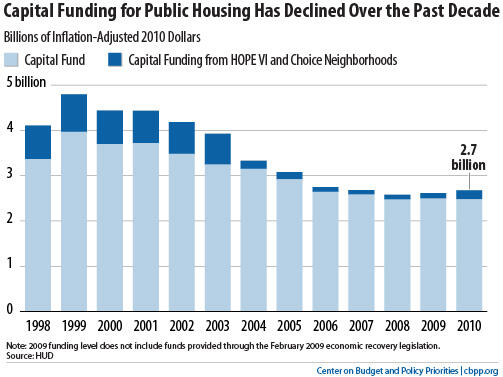off the charts
POLICY INSIGHT
BEYOND THE NUMBERS
BEYOND THE NUMBERS
Fixing Leaky Roofs — and Protecting a Federal Investment
Receive the latest news and reports from the Center
Many low-income families living in public housing have to cope with crumbling ceilings, faulty plumbing, and other unmet repair needs, the New York Times reported Monday. The main cause is a lack of capital funding to repair and renovate the developments, most of which were built decades ago. Fixing this problem is critical to the long-term success of this essential program.
The federal government has underfunded public housing for much of the program’s seven-decade history and made especially deep cuts from 2002 through 2006 (see graph). The 2009 Recovery Act included $4 billion that local housing agencies are using to repair many public housing developments — and, in the process, help preserve jobs in the hard-hit residential construction sector. But with the developments’ overall repair needs estimated at over $20 billion, much of the problem remains unaddressed.

This underfunding has put at risk the vital, though often underappreciated, safety net that public housing provides for more than 2 million low-income Americans. Almost two-thirds of families in public housing have at least one member who is elderly or has a disability; most other residents are working families with children. The stability that public housing provides these families is particularly crucial today, with job losses high and homelessness rising among families with kids.
And as the Times’ story makes clear, the federal government’s failure to address public housing’s repair needs is penny wise but pound foolish. Minor problems like drafty windows or leaky roofs can drive up utility bills or lead to more severe damage that will be costlier to repair. In fact, many public housing developments have already deteriorated to the point where housing agencies have had no choice but to demolish them, wasting decades of federal and local investment.
The Administration has proposed an aggressive plan to give agencies more adequate public funding for public housing, as well as greater access to private financing. While Congress should strengthen the proposal — Preservation, Enhancement, and Transformation of Rental Assistance (PETRA) —in some ways, it offers a promising framework for preserving public housing developments over the long term.
More immediately, Congress will set funding levels for public housing when it finalizes the 2011 appropriations bills after the election. The full House and the Senate Appropriations Committee have each approved funding close to (or slightly above) last year’s level for operating and renovating public housing, but public pressure has since grown to cut federal spending in a wide range of areas. Slicing public housing funding below current levels would only increase the program’s unmet needs.